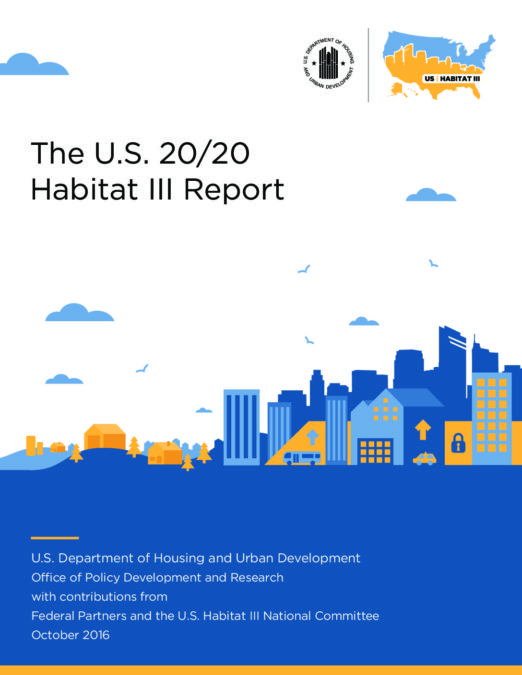
United States of America
Urban indicators:
| Value | Year | ||
| Surface area (sq km) | 9833517 | 2014 | |
| Population (proj., 000) | 324119 | 2016 | |
| Pop. density (per sq km) | 35.4 | 2016 | |
| Capital city | Washington, D.C. | 2015 | |
| Capital city pop. (000) | 4955 | 2015 | |
| Population growth rate (average annual %) | 0.8 | 2010-2015 | |
| Urban population growth rate (average annual %) | 1.0 | 2010-2015 | |
| CO2 emission estimates (000 tons/tons per capita) | 5186168/16.1 | 2013 | Including overseas territories. |
| Population using improved drinking water sources (urban/rural, %) | 99.4/98.2 | 2015 | |
| Population using improved sanitation facilities (urban/rural, %) | 100.0/100.0 | 2015 |
| 1995 | 2005 | 2014/2015 | |
| Urban population ('000) | 207,080 | 238,319 | 265,361 |
| Level of urbanization (%) | 77.3 | 79.9 | 81.6 |
National Report:
National Report Executive Summary:
Since 1996, Americans increasingly reside in urban areas—this trend is likely to continue through the next two decades. Demographic trends indicate that population growth will be concentrated among American youth and people over 65. The nation has become more diverse since Habitat II and will become even more diverse and non-White for the foreseeable future.
These and other trends will require integrated, comprehensive policies and approaches to facilitate upward mobility, sustainable and inclusive communities, and economic and environmental resiliency. Achieving this balance requires alignment of federal, state, and local actors and partnerships with civil society and the private sector. Each of these actors must work together to achieve collective impact.
The last 20 years laid bare a tale of deep contrasts in the United States: unparalleled economic growth and resilience of certain geographies domestically, yet deepening income inequality among people writ large. The wealthy have gotten wealthier, and the vulnerable are more fragile. The nation has innovated in housing and sustainable urban development, through initiatives like Choice Neighborhoods and the Sustainable Communities Initiative. HUD alone provides billions in housing assistance, but the United States continues to face an affordable housing crisis. The federal government is galvanizing cross-silo investments and approaches, but the capacity for integrated work is still limited. New partnerships have been fostered across the public, private, and nonproft sectors, but these initiatives need to be scaled up if we are to reduce wealth disparities. We know more about what works and have created the data and systems to transparently disseminate the effects of our interventions, yet evidence and research and policies and programs are not fully aligned.
Our global interdependence means that the ripple effects of changes are felt by everyone more rapidly. The urbanization trend is a global one, especially with the exponential increase of megacities. Political instability and terrorism are visited upon cities often regardless of what steps are taken in national capitals to control crises. Cities have become magnets for the influx of migrants and refugees who lay claim to their new lives in new places, balancing assimilation with maintaining cultural and religious affnities. Even as political, economic and social phenomena threaten the status quo in places, natural resource scarcity (e.g., access to quality, clean air and water) make basic livability challenging in regions.
Despite all of the challenges befalling the urban environment, cities nonetheless continue to be the hubs of innovation. In cities around the globe, technological innovations are redefning the effective and effcient delivery of services, from transportation and infrastructure to recreation and leisure, to educational and employment opportunities, to other yet undiscovered terrain. Cities will be where many of our problems frst manifest but also where many of their solutions will be constructed. Habitat III arrives at a moment when the seemingly perilous challenges ahead surely can be overtaken by the hopeful vision of what is possible. The challenges outlined above do not bear repeating because they are largely known and understood. However, less predictable is the resolve of nations recently seen through the Sustainable Development Goals (SDG) and COP21 processes that indicate a willingness to build the structures, invest the resources, align to best practices, and partner more effectively to make a greater impact. Collective resolve by nations will be the test.
Statistics:
Urban housing indicators
Urban population with access to adequate housing (%)
Basic services and infrastructure
Urban population with access to safe drinking water (%)
Urban population with access to adequate sanitation (%)
Urban population with access to regular waste collection (%)
Urban population with access to public transport (%)
Level of effective decentralization
Share of both income and expenditure allocated to local governments from the national budget (%)
Share of local authorities’ expenditure financed from local revenue (%)
Indicators for urban policies, legislation and economy
Share of national gross domestic product (GDP) that is produced in urban areas
Statements by United States of America:
-
Habitat III Plenaries
-
Intersessionals: Open-ended Informal Consultative Meetings
-
Intersessionals: Informal Intergovernmental Meetings (May 2016)
Comments on Preparatory Process Documents:
Events:
- At the Habitat III Conference:

Food Insecurity and Climate Change in Cities: Meeting Challenges Through an Integrated Approach
- More events:

Jane’s Walk: Four Freedoms Park, Roosevelt Island and the New Urban Agenda

Presentation of the Shanghai Manual at UN Headquarters

Informal Intergovernmental Meetings 7–10 SEPTEMBER 2016, New York

A Briefing on Habitat III

Western Asia: Urban Challenges and Sustainable Development

Inclusive Redevelopment – Frederick Douglass Boulevard Corridor

North America: Urban Challenges and Sustainable Development

Holistic & Participatory Planning w/in Pressures of Inequality

Housing & Public Spaces: Historic Neighborhood in Transition

Europe: Urban Challenges and Sustainable Development

Urban Challenges from the Perspective of Small Island States

Urban Deltas—Hotspots for Prosperity or Despair?

Africa: Urban Challenges and Sustainable Development

Asia–Pacific: Urban Challenges & Sustainable Development

Latin America-the Caribbean: Urban Challenges & Sustainable Development

Urban Thinkers Campus

Expert Group Meeting on Women and the New Urban Agenda

Preparatory Committee I (PrepCom1)



